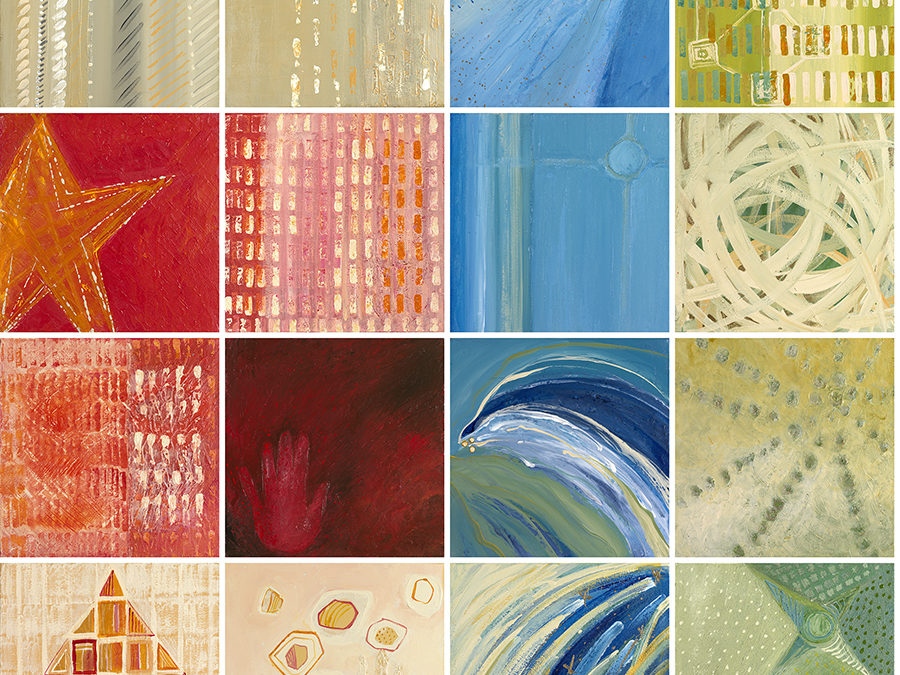
by Sandy | Jul 3, 2018 | Personal Expression
What’s next? What’s possible? Where is the growing edge? How can I play there?
These are the questions that motivate me and make me want to grow and that fuel my creativity. This is not the path that all artists take but it seems to be mine.
The spark for this painting came from committing to a show in October that will feature the work of artist members of Verity, a women’s club/haven/community in Toronto. Since each participant will have 3 pieces, this became an opportunity to try a new direction or a least a new medium.
That meant … cement.
Cement meant Andrew Crane.
I know Andrew because I follow him on Facebook and have been continually inspired and intrigued by his work.
Thus began a cycle of trusting and reaching.
Trust – if Andrew could do cement I could do cement.
Reach – if a Google search for “how to” use cement on canvas turned up Andrew Crane as the only resource, I could dare to ask him for advice.
The reward – an encouraging response from Andrew with complete detailed steps.
Trust – that I could find the equivalent of the materials that Andrew was using in the UK in cottage country Ontario.
Trust – that I could find my way not only with the material, but with what I wanted to say – surely I needed something new and significant to say.
After several rounds of practice on recycled boards and old canvas, I had a sense of cement but was at a loss for what I wanted to express.
Reach – this was a combination of letting things come to me and exploring out in the world so that there were points of contact for subject matter to arise.
Trust – the thing was that I trusted that the attraction to the immediate and very raw aspect of cement was bigger than my not knowing what to do with it – just yet.
Reach can be described in this context as trusting the process – Was it relevant that I was very shocked and saddened by the untimely death of the leader of the NDP, Jack Layton – right when I was seeking meaningful expression? On Facebook I followed the postings of the chalk homage at City Hall, the outpouring of genuine affection from across Canada from people of all ages, creeds and political affiliations. I wept through the televised funeral.
BINGO – I needed to to harness my own raw emotion and that of the people I was responding to on Facebook and raw cement provided the perfect medium.
Even when I realized that I had mistakenly quote Shawn Atleo as saying “from sea to sea to sea” during the blessing at the service for Jack, I trusted that I could redo the background in order to write ” from coast, to coast to coast. This trust comes from hours and hours of applying paint. If I messed up I know that I can keep going and eventually turn the corner back to something I like.
I am content with what I have done – I trust it to be recognized or not and it doesn’t matter. It feels good that I am not concerned with the opinions of others – at the moment. They may not dig cement on their walls and that’s OK. I get it and have an inner chuckle at the multiple layers and hidden meanings at play in my mind.
Pure cosmic fun!!! That is a reward worth appreciating.

by Sandy | Jul 3, 2018 | MBTI Facts, Other Personality Assessments
When people ask me what I do and I mention assessments such as the MBTI, I get a variety of reactions. Some people’s eyes glaze over as they say “You what?” Obviously they have never experienced a personality assessment other than possibly a quiz in a magazine they may have done as a teenager. There are others who say “I did that once”, but have no idea which tool was used nor what their particular results indicated. The rare individual can rhyme off their results from a variety of assessment tools and indicate how they play out in their work life. What is common is that people who have done one of the temperament assessments or another 4 part, model such as Social Styles will remember either the colour or an aspect of their type.
In a recent conversation, a woman was excited to talk about just how Gold she was – “off the charts” as she described her uber-organized style. She had a real sense of how those preferences suited the work she was in and just as aware of how it was a source of possible friction in her home life.
What occurred to me during our conversation was how useful a simple model was in a work context where people have something like colour to anchor their memory. Assessments of any kind are only of value if they are applied. What does this tell me about my strengths? What does it tell me about how others may perceive my actions? How can I become increasingly aware of my “blindspots”?
The other thought I had was that personal development is so important to me that at times I forget that some people could care less. Those of us who see the value in using tools to learn about ourselves and others, may readily see that having insights from a number of tools is simply a more meaningful approach to understanding. Those who value personal development are willing to take the time to learn about and apply more complex instruments.
So even though I have a personal preference for the distinctions made by the Step 2 version of the MBTI that gives a break down of 5 sub-pairs for each preference pair, some people simply want to know I am Gold and this is a good thing for my job. What works depends on the context and the interest of the people involved. Start wherever you are. KISS Keep it simple is sometimes the best motto.

by Sandy | Jun 29, 2018 | Best Practices, MBTI Facts
Follow-up is critical to your reputation and to building and maintaining relationships with your clients, customers and colleagues. “But I’m so busy” you groan “I don’t have time to do all that follow up.” Well I’m afraid this is one of those “You can’t afford not to” situations. Let’s see what follow up means and then look at some MBTI preference specific tips to make it easier.
Things to consider about follow-up
- Follow-up is required for every phase of engagement so it is important to identify the cycle of each client/customer interaction; for example, the initial discovery appointment, contracting, delivery, end of delivery review. Your process will be different but there will be some variation on a beginning, a middle and an end. It is helpful to know where you are in the cycle and what is required at each stage.
- To determine what is required at each stage, stand in your client/customers shoes. Try to understand what they might be needing right now so that you can follow-up. What questions do people typically have at this stage and have you answered them? If either you or the client have to gather more information or consult with others before a decision can be made have you created a time frame? Here is an important place to follow up no matter who has the ball. Make the call either way to keep the ball in play.
- Think “be of service.” Just because you haven’t heard back from someone doesn’t mean they have forgotten you. They too may be busy. Following up with an offer to help to answer any questions or address any concerns may bring you back to top of mind.
- Understand what you are agreeing to. People often say YES before they consider the ramifications of that commitment. It is perfectly fine to say that you would like to think about it or a day or two. Then it is important to get back with a ‘yes’ a ‘no’ or a counter offer. On this same note be aware of any implied agreements or expectations and be mindful if you agree to them or not. You may wish to surface them for a conversation.
- If you do agree to something, have a mechanism to make note of it and put a specific date on it so that you can monitor that you completed the item.
- If someone else agrees to do something, make a note of that too and follow up after a grace period so that they don’t feel that they are being hounded. The idea is to be helpful.
- If you find that you don’t have the resources or time to honour an agreement, say so in time for the person to make other arrangements. If you can offer them another solution even better even if it is your competition. The client or customer will appreciate your honesty and your reputation will remain intact.
Making follow-up easy (with a nod to your MBTI preferences)
- Automate or systematize this process if what you are offering allows for that. Personally I would need to hire someone to design this process for me as my ENFP preferences are better suited to other tasks.
- Identify your preferred way of communicating – email was made for Introverts. If that is how you like to get things done, let your clients know. Make it easy for both of you by declaring something like… “email requests are returned withing X amount of time”. Then be demanding of yourself that you do just that.
- Extraverts may wish to have a follow-up phone call. That way, you can get a quick grasp of the whole issue and hear if there are any unspoken concerns. It may work for you to have a specific time of day for making and taking calls, and let people know that you are available for phone calls between 8am and 10am for example. Then it goes without saying – be there.
- Consider whether some aspects of follow-up can be delegated to an assistant who can troubleshoot and screen what things need to be handled by you. Someone with a preference for Intuition can train an assistant to answer FAQ freeing them from repetitive detailed responses.
- For Perceivers – Understand what the person is asking if they make a request and answer “that” question only. No need to expand to other areas and open up something for no reason.
- For those with a Thinking preference- Most buying decisions are made with an underlying values based bias which is backed up with cool rational analysis. In other words, if you like it you’ll buy it (or hire a person etc.). So please don’t underestimate the Feeling aspect of decision making. Some of your follow up may be in preventing buyers remorse or dealing with people’s values based objections or their feelings. Follow-up may be simply listening to their concerns – without the need to “fix’, provide arguments or question them.
- Those with a preference with Judging can be of tremendous value to Perceivers in keeping a project moving forward in a timely manner. If you have just rolled your eyes at the though of yet again playing this role for people who should have it together, consider the possible advantage that this gives you. Then there is the huge ‘value add’ you give your clients if you can follow -up with kindness. Think of it this way… “Those who have the capability have the opportunity (responsibility) to use it.”
- For those with a Sensing preference, be aware of the exactly how much detail the client wants in order to be satisfied. They may want to leave all of the technical details to you and just need a yes or no answer. This also goes to the amount of follow up – some clients may not need to be contacted as often as others depending on their experience and need for information.
- For those with a Feeling preference – my suggestion in an ideal world would be to work in a business you believe in working for clients whose values are in alignment with yours. In the real world, step into the clients shoes and deliver according to their requirements. If what they want does not cross an ethical boundary, tailor your follow up to their needs and preferences not yours.
- In a nutshell, think of follow-up as part of building your business not as a nuisance and see if that makes if more palatable. It is all about maintaining trust and developing strong relationships. Your reputation is worth gold.

by Sandy | Jun 27, 2018 | Best Practices, MBTI Facts
How much time and effort do you put into promoting yourself and what you do? Add to that the amount of time you spend on the business you have contracted to deliver. Between the promoting and delivering are a myriad of steps that require attention…returning phone calls, clarifying needs, perhaps submitting a proposal, strengthening and maintaining relationships. The list goes on.
Consider the following tale of “follow up” success and failure. Compare these three experiences in getting quotes for a specific service.
Supplier #1
The website is straightforward and business-like with no bells and whistles. A few days after the initial conversation called back to say that given the complexity of the requirements, his limited resources and the time frame, he thought it would be best if he passed on making a quote. He could probably have delivered but he didn’t have the bandwidth if there were additional complications.
Supplier #2
Their website is like eye candy – everything you might want for your business. It boasts a team of experts and the examples of the work they have done is terrific. Emails and phone messages were returned a week later to set up a call. Documents and a discovery phone call resulted in a promise to return a quote within a day. Three weeks later and I haven’t heard a peep.
Supplier #3
Their website is high quality and professional. After an initial call to get an idea of the scope of the project a conference call was held with three of their experts on board. The needs of the situation were fully explored and understood. A complete proposal with costs and timeline was presented within 3 business days.
Resuts
Supplier #3 was hired and in action one day later. I am not alone in this endeavour. Everyone involved in this project will be an ambassador for this company for years to come. Supplier #1 also scored big time in my books because they were honest in a timely manner. I would definitely use their services in the future because they maintained their trust.
Supplier #2 lost trust and respect. I hope that it was an anomaly but I have no reason to try them again or recommend them to others. I am so disappointed because they looked so good online.
MBTI tips
Follow through may be more natural for someone with a preference for Judging. I know that my ENFP preferences do not contribute to my being a movie star in this area. However, being on the receiving end of poor follow up reinforced the importance to one’s reputation. The impact stretches far beyond one event.
If follow up isn’t your strong suit design systems to help you take care of every aspect of your business where follow up counts. Autoresponders do this for the part of your business that is online. What do you do to ensure that you don’t drop the ball?

by Sandy | Jun 25, 2018 | Other Personality Assessments, Reiss Motivation Profile
Why am I talking about “desire” on a blog that has much of its content to be dedicated to the MBTI?
Personality assessments are tools. The way I like to use them – they are tools to use as a lens to open a conversation or inquiry. The purpose of the exploration being gaining knowledge of self or others. And as the old adage goes a “Woman is only as good as her tools.” If she has only one tool she is limited in what gets built. To continue with the cliches “if you only have a hammer everything becomes a nail.”
Hence, my passion for knowing multiple assessment tools. When I have multiple lenses the look through I see aspects that aren’t illuminates by just one facet of the prism. I have picked three tools to focus on that work for me: the MBTI for understanding how we process information and make decisions, the Enneagram for a deeper look at worlview and the resulting dynamics and the Reiss Desire Profile for exploring core motivation. Some of the others that I am familiar with and recomment for different circumstances include the Kolbe, the DISC, the PIAV and of course other type and tempaerament tools such as Insights, True Colors and the Kiersey Temperament Sorter.
What is the Reiss?
The Reiss Profile is a comprehensive, standardized, objectively validated instrument that assesses 16 basic psychological needs. This knowledge build on work by Maslow and Allport but one differentiator is that Reiss’s work is testable. Dr. Steven Reiss research included over 10,000 surveys with ordinary people across a wide spectrum of life situations. He mathematically reduced hundreds of wants, needs and desires down to be captured by these 16 desires.
Every individual has some proportion of all 16 basic needs. Dr. Reiss was looking to understand values based happiness. What he discovered is that how a person prioritizes the 16 needs can predict their behaviour…whether the person will be an organ donor, how they will respond in school, in romantic situations or with regard to religion.
This profile is a trait based model so that rather than discovering your type, you being to see a constellation of which traits apply to you and which do not.
The 16 basic psychological needs are:
Power, the need for influence of will
Independence, the need for individuality
Curiosity, the need to think
Acceptance, the need for approval
Order, the need for organized, stable, predictable environments
Saving, the need to collect
Honour, the need to be loyal to the traditional values of one’s clan
Idealism, the need for social justice
Social Contact, the need for friends (peer relationships)
Family, the need to raise children
Status, the need for social standing/importance
Vengeance, the need to strike back
Romance, the need for sex
Eating, the need for food
Physical Activity, the need for exercise
Tranquility, the need to be safe
Inner Landscapes looks at a few of these desires in more detail. It may spark your interest to see how this profile might apply to you and your business.





